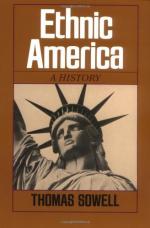
|
| Name: _________________________ | Period: ___________________ |
This test consists of 15 multiple choice questions and 5 short answer questions.
Multiple Choice Questions
1. Which ethnic group has the highest fertility rates?
(a) Mexican-Americans.
(b) Chinese Americans.
(c) Polish Americans.
(d) Blacks.
2. What kind of work provided a start for most wealthy American Jewish families?
(a) Unskilled labor.
(b) Peddling.
(c) Manufacturing.
(d) Farming.
3. Who developed the term "kike" to refer to Eastern European Jews in the U.S.?
(a) Blacks.
(b) The Irish.
(c) The British.
(d) German Jews.
4. How many people died of starvation or illness during the Great Famine of the 1840s in Ireland?
(a) Two hundred thousand.
(b) Five million.
(c) One million.
(d) Five hundred thousand.
5. Which group of Jews in New York were more established and wealthier?
(a) Uptown Jews.
(b) Downtown Jews.
(c) Russian Jews.
(d) Yiddish-speaking Jews.
6. Which group was the most isolated of the early German settlers?
(a) The Catholics.
(b) The Amish.
(c) The Mormons.
(d) The Mennonites.
7. What system did Italian immigrants use to finance business ventures?
(a) Banks.
(b) Crime syndicates.
(c) Credit unions.
(d) Mutual aid societies.
8. What industry did most German immigrants pursue?
(a) Manufacturing.
(b) Publishing.
(c) Farming.
(d) Transportation.
9. How long did it take to cross the Atlantic in a steamship?
(a) Ten days.
(b) Ten weeks.
(c) Ten months.
(d) Two months.
10. What is the largest single ethnic group in the U.S.?
(a) Irish.
(b) British.
(c) Italian.
(d) Mexican.
11. The highest fertility rates are found in groups with the ________________ incomes.
(a) Highest.
(b) Fastest-growing.
(c) Lowest.
(d) Most stable.
12. What distinguishes Italian emigration during the 20th century?
(a) More immigrants return to Italy than leave it.
(b) All of the emigration is to the U.S.
(c) It is the slowest exodus from a single nation.
(d) It is the largest exodus from a single nation.
13. What important social change did Germans bring to the mainstream culture?
(a) Respect for science.
(b) Beer drinking.
(c) Stricter morals and mores.
(d) Promotion of family entertainment.
14. In what area did 19th century Germans consider themselves superior to Irish?
(a) Americanization.
(b) Education.
(c) Religion.
(d) Sports.
15. Discrimination against Irish workers was exemplified in the phrase, "No Irish need ____________."
(a) Enter.
(b) Apply.
(c) Purchase.
(d) Venture.
Short Answer Questions
1. How did Italian immigrants to the U.S. regard education?
2. What percentage of arrests in New York City during the 1850s were made of drunk and disorderly Irishmen?
3. Which group represents the most dramatic example of upward mobility among immigrants?
4. How many years did a German indentured servant typically have to work to pay off his transportation to America?
5. During the decades surrounding the beginning of the 20th century, what proportion of Eastern European Jews moved to the United States?
|
This section contains 418 words (approx. 2 pages at 300 words per page) |

|




